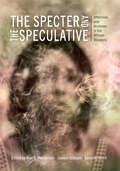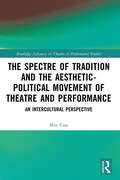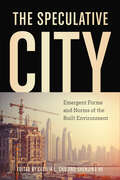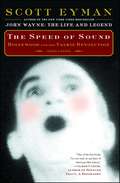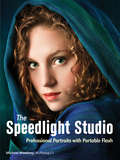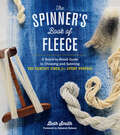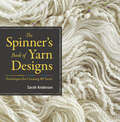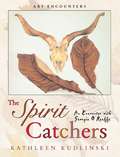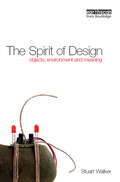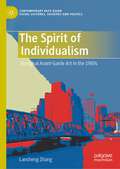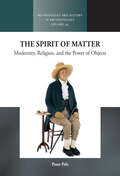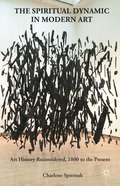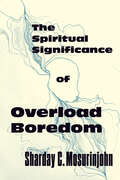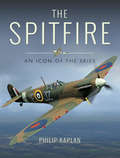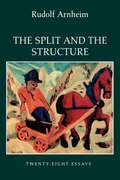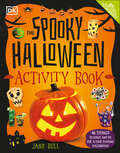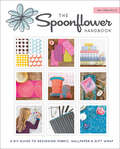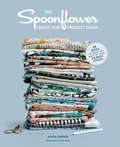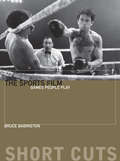- Table View
- List View
The Specter and the Speculative: Afterlives and Archives in the African Diaspora
by Mae G. Henderson Jeanne Scheper Emily Ruth Rutter Danielle Fuentes Morgan Fernando Gabriel Pagnoni Berns Gene Melton Diana Arterian Christopher Giroux Stella Setka Meina Yates-Richard Luis Omar Ceniceros Shamika Ann Mitchell Andrew R. Belton Kim White Sheila Smith McKoy Pekka Kilpeläinen Emiliano Aguilar Juan Ignacio Juvé Kajsa K. Henry McKinley E. MeltonThe Specter and the Speculative: Afterlives and Archives in the African Diaspora engages in a critical conversation about how historical subjects and historical texts within the African Diaspora are re-fashioned, re-animated, and re-articulated, as well as parodied, nostalgized, and defamiliarized, to establish an “afterlife” for African Atlantic identities and narratives. These essays focus on transnational, transdisciplinary, and transhistorical sites of memory and haunting—textual, visual, and embodied performances—in order to examine how these “living” archives circulate and imagine anew the meanings of prior narratives liberated from their original context. Individual essays examine how historical and literary performances—in addition to film, drama, music, dance, and material culture—thus revitalized, transcend and speak across temporal and spatial boundaries not only to reinstate traditional meanings, but also to motivate fresh commentary and critique. Emergent and established scholars representing diverse disciplines and fields of interest specifically engage under explored themes related to afterlives, archives, and haunting.
The Spectre of Tradition and the Aesthetic-Political Movement of Theatre and Performance: An Intercultural Perspective (Routledge Advances in Theatre & Performance Studies)
by Min TianThis book interrogates anew the phenomenon of tradition in a dialogical debate with a host of Western thinkers and critical minds. In contrast to the predominantly Western approaches, which look at traditions (Western and non-Western) from a predominantly (Western) modernist perspective, this book interrogates, from an intercultural perspective, the transnational and transcultural consecration, translation, (re)invention, and displacement of traditions (theatrical and cultural) in the aesthetic-political movement of twentieth-century theatre and performance, as exemplified in the case studies of this book. It looks at the question of traditions and modernities at the centre of this aesthetic-political space, as modernities interculturally evoke and are haunted by traditions, and as traditions are interculturally refracted, reconstituted, refunctioned, and reinvented. It also looks at the applicability of its intercultural perspective on tradition to the historical avant-garde in general, postmodern, postcolonial, and postdramatic theatre and performance and to the twentieth-century "classical" intercultural theatre and the twenty-first-century "new interculturalisms" in theatre and performance. To conclude, it looks at the future of tradition in the ecology of our globalized theatrum mundi and considers two important interrelated concepts, future tradition and intercultural tradition. This book will be of great interest to students and scholars in performance studies.
The Speculative City: Art, Real Estate, and the Making of Global Los Angeles
by Susanna Phillips NewburyA forensic examination of the mutual relationship between art and real estate in a transforming Los Angeles Underlying every great city is a rich and vibrant culture that shapes the texture of life within. In The Speculative City, Susanna Phillips Newbury teases out how art and Los Angeles shaped one another&’s evolution. She compellingly articulates how together they transformed the Southland, establishing the foundation for its contemporary art infrastructure, and explains how artists came to influence Los Angeles&’s burgeoning definition as the global city of the twenty-first century.Pairing particular works of art with specific innovations in real estate development, The Speculative City reveals the connections between real estate and contemporary art as they constructed Los Angeles&’s present-day cityscape. From banal parking lots to Frank Gehry&’s designs for artists&’ studios and museums, Newbury examines pivotal interventions by artists and architects, city officials and cultural philanthropists, concluding with an examination of how, in the wake of the 2008 global credit crisis, contemporary art emerged as a financial asset to fuel private wealth and urban gentrification. Both a history of the transformation of the Southland and a forensic examination of works of art, The Speculative City is a rich complement to the California chronicles by such writers as Rebecca Solnit and Mike Davis.
The Speculative City: Emergent Forms and Norms of the Built Environment
by Shenjing He Cecilia L. ChuThe Speculative City explores property speculation as a key aspect of financialization and its role in reshaping the contemporary built environment. The book offers a series of case studies that encompass a range of cities whose urban fabrics have undergone significant transformation in recent years. While the forms of these developments shared many similarities, their trajectories and social outcomes were contingent upon existing planning and policy frameworks and the historical roles assumed by the state and the private sector in housing and welfare provision. By paying close attention to the forces and actors involved in property development, this book underscores that the built environment has played an integral part in the shaping of new values and collective aspirations while facilitating the spread of financial logics in urban governance. It also shows that these dynamics represent a larger shift of politics and culture in the ongoing production of urban space and prompts reflections on future trajectories of finance-led property speculation.
The Speed of Sound: Hollywood and the Talkie Revolution 1926-1930
by Scott EymanFor the first time ever, here is the epic story of the transition from silent films to talkies - that moment when movies were totally transformed and the American public cemented its love affair with Hollywood. In the Speed of Sound, author Scott Eyman, whose biography of filmmaker Ernst Lubitsch was hailed as "resoundingly wonderful," has created a mixture of cultural and social history that is at once both scholarly and vastly entertaining. Here is the first and last. word on the missing chapter in the history of Hollywood, the ribbon of dreams by which America conquered the world. Myth has it that it happened overnight, that Al Jolson said a few words in The Jazz Singer and the talkies were born, that stars with weak or inappropriate voices either killed themselves or went into seclusion, that the movie industry simply refitted itself and went on with business. The truth, however, is more involved - not to mention sinister, colorful, and entertaining. Sound was something the industry had resisted, and it was accepted only reluctantly and only after the Warner Bros. Studio had forced the issue with its aggressive selling of The Jazz Singer. But that was 1927, and for a long time afterward there were still those filmmakers, film stars, and even some filmgoers who resisted the appealing novelty. Change, however, was inevitable, and when it came it was devastating. As Scott Eyman demonstrates in his fascinating account of this exciting era, it was a time when fortunes, careers, and lives were made and lost, when the American film industry came fully into its own, and when the American film-going public truly succumbed to Hollywood's bewitching spell.
The Speedlight Studio
by Michael MowbrayIn this book, Michael Mowbray shows readers how to set up a completely speedlight-based portrait photography studio. He goes in depth regarding gear and techniques, providing photographers with scores of example portraits and lighting diagrams to make it easy to follow along and replicate the portrait lighting effects that he shows. Readers will learn about selecting speedlights (Mowbray covers Canon, Nikon, and third-party units), learning standard operations, and working with the units on the camera’s hot shoe (a connectivity device on top of the camera) or in the periphery for more flexible, controllable results. Readers will learn why modifying the light from speedlights will produce a lot more bang for their buck and will also discover a host of tools-commercial and DIY-that can be used to change the direction, color, and quality of light for the ultimate artistic control.
The Speedlight Studio
by Michael MowbrayIn this book, Michael Mowbray shows readers how to set up a completely speedlight-based portrait photography studio. He goes in depth regarding gear and techniques, providing photographers with scores of example portraits and lighting diagrams to make it easy to follow along and replicate the portrait lighting effects that he shows. Readers will learn about selecting speedlights (Mowbray covers Canon, Nikon, and third-party units), learning standard operations, and working with the units on the camera’s hot shoe (a connectivity device on top of the camera) or in the periphery for more flexible, controllable results. Readers will learn why modifying the light from speedlights will produce a lot more bang for their buck and will also discover a host of tools-commercial and DIY-that can be used to change the direction, color, and quality of light for the ultimate artistic control.
The Speedlight Studio
by Michael MowbrayIn this book, Michael Mowbray shows readers how to set up a completely speedlight-based portrait photography studio. He goes in depth regarding gear and techniques, providing photographers with scores of example portraits and lighting diagrams to make it easy to follow along and replicate the portrait lighting effects that he shows. Readers will learn about selecting speedlights (Mowbray covers Canon, Nikon, and third-party units), learning standard operations, and working with the units on the camera's hot shoe (a connectivity device on top of the camera) or in the periphery for more flexible, controllable results. Readers will learn why modifying the light from speedlights will produce a lot more bang for their buck and will also discover a host of tools-commercial and DIY-that can be used to change the direction, color, and quality of light for the ultimate artistic control.
The Spice Must Flow: The Story of Dune, from Cult Novels to Visionary Sci-Fi Movies
by Ryan BrittGeek-culture expert Ryan Britt takes us behind the pages and scenes of the science-fiction phenomenon Dune, charting the series' life from cult sci-fi novels to some of the most visionary movies of all time. Using original, deep-access reporting, extensive research, and insightful commentary, The Spice Must Flow brings the true popularity of Dune out into the light for the very first time. With original interviews with the beloved actors and directors behind the films—including Timothée Chalamet, Kyle Maclachlan, Denis Villeneuve, Patrick Stewart, Rebecca Ferguson, Alec Newman, and many more— The Spice Must Flow also examines the far-reaching influence of Dune on art, music, politics, and, most notably, its status as the first ecological science-fiction story specifically concerned with climate change. Britt skillfully and entertainingly guides readers through the history of how the Dune universe has unfolded, including the novel&’s unlikely evolution from a failed piece of journalism about Oregon sand dunes into an epic science-fiction story, the way Herbert&’s work inspired George Lucas, untold stories from the 1984 David Lynch film, the knife-edge balance between blockbuster hit and indie film Timothée Chalamet brings to the 2021 movie, and the exciting future of the franchise. Through a blend of narrative, oral history elements, and fascinating trivia, The Spice Must Flow is the new essential guide to the behind-the-scenes story of Dune. The fiction of Dune is deadly serious, but the real-life story of how it came into existence is full of wonder, surprises, and spice.
The Spinner's Book of Fleece: A Breed-by-Breed Guide to Choosing and Spinning the Perfect Fiber for Every Purpose
by Deborah Robson Beth SmithThe characteristics of fleece — its structure, grease content, and fiber diameter — vary widely depending on the breed of sheep the fleece comes from. In this comprehensive guide, Beth Smith profiles 21 types of fleece, from bouncy and pliant to lacy and lightweight. A sheep-by-sheep reference describes the best way to wash and spin each fleece into rich, soft yarn. You’ll soon be confidently choosing the right fleece, spinning it to perfection, and enjoying the perfect yarn for your next fiber creation.
The Spinner's Book of Yarn Designs: Techniques for Creating 80 Yarns
by Sarah Anderson Judith MacKenzieDiscover the satisfying fun of spinning your own yarn! This step-by-step guide shows you how to create 80 distinctive yarn types, from classics like mohair bouclé to novelties like supercoils. Covering the entire spinning process, Sarah Anderson describes the unique architecture of each type of yarn and shares expert techniques for manipulating and combining fibers. Take your crafting to a new level and ensure that you have the best yarn available by spinning it yourself.
The Spirit Catchers: An Encounter with Georgia O'Keeffe (Art Encounters)
by Kathleen V. KudlinskiArt Encounters brings the work of famous artists to life through thrilling and evocative stories that reflect the individual paintings featured. This new series of historical fiction introduces young readers to the styles, methods, techniques, and influences of great painters. History and fiction merge in this uplifting novel about a boy whose artistic talent awaits a great mind to uncover it. A child of the Depression, Parker begins his relationship with O'Keeffe by stealing her property, notably a camera. She is prepared to let him rot in jail when she develops the photos he has taken with the stolen camera and recognizes the boy's raw ability. Set against the backdrop of New Mexico's stark beauty, Parker's struggle to find his artistic vision clashes with O'Keeffe's fierce independence and private nature. Parker tries to connect with his surroundings through the use of a camera, while O'Keeffe uses it as an aid for finding points of view otherwise difficult to obtain. This book is a literary interpretation of O'Keeffe's paintingRam's Skull with Brown Leaves, as well as an intimate look at the artist's fame, her relationship with Alfred Stieglitz, and her creative process. Georgia O'Keeffe in New Mexico Georgia O'Keeffe's single greatest inspiration was the New Mexican desert. She went "half mad with love for the place. " There O'Keeffe collected the dry, white animal bones scattered over the desert, and painted her first "bone" paintings, includingRam's Skull with Brown Leaves. After 1934, she returned to New Mexico every summer, moving there permanently after the death of her husband, the art impresario Alfred Stieglitz. When O'Keeffe visited the Ghost Ranch in Abiquiu, New Mexico, she knew immediately that she wanted to live there. Later, she bought and restored an abandoned hacienda nearby. Although failing eyesight forced her to stop painting with oil in the 70's, she continued to use pencil and watercolor. Active long into her later years, O'Keeffe died in 1986 at the age of 98. * For readers ages 12 and up * The first book in the new Art Encounters series * The story is based around O'Keeffe's paintingRam's Skull with Brown Leaves(Roswell Museum and Art Center, Roswell, NM) * Georgia O'Keeffe is one of the top five most studied artists in American schools
The Spirit of Design: Objects, Environment and Meaning
by Stuart WalkerImaginative design will be a crucial factor in enacting sustainability in people's daily lives. Yet current design practice is trapped in consumerist cycles of innovation and production, making it difficult to imagine how we might develop a more meaningful and sustainable rendition of material culture. Through fundamental design research, The Spirit of Design challenges a host of common assumptions about sustainability, progress, growth and globalization. Walker's practice-based explorations of localisation, human meaning and functional objects demonstrate the imaginative potential of research-through-design and yield a compelling, constructive and essentially hopeful direction for the future - one that radically re-imagines our material culture by meshing mass-production with individuality, products with place, and utilitarian benefit with environmental responsibility. In so doing, the author explores: - How understandings of human meaning affect design and how design can better incorporate issues of personal meaning - How mass production needs to become integrated with localised production and service provision - How short-lived electronic goods can be brought into a more sustainable design paradigm - The changing role of the designer in a post-consumerist world Taking a design-centred approach - a combination of creative, propositional design practice, reasoned argument and theoretical discussion - the book will impel readers to investigate the nature of contemporary material culture and its relationship to both the natural environment and to deeper notions of human meaning.
The Spirit of Individualism: Shanghai Avant-Garde Art in the 1980s (Contemporary East Asian Visual Cultures, Societies and Politics)
by Lansheng ZhangThis book is about avant-garde art in Shanghai in the 1980s which challenges the narrative in the current discourse on the appearance of contemporary art in China. Offering fresh perspectives and new insights into the art and the artists of this period, the book includes critical events in Shanghai, that will attract the serious attention of art professionals and collectors. The emergence of the Shanghai art scene in the 1980s mirrors the revitalisation of Shanghai that was tasked to lead China’s economic development trajectory onto the world stage. Shanghai, with its semi-colonial, political, economic and cultural history, including the strong legacy of the early twentieth century modernist art movement, has played a vital role in China’s modernisation and presents itself as a unique case in the evolution of contemporary art in China.
The Spirit of Matter: Modernity, Religion, and the Power of Objects (Methodology & History in Anthropology #45)
by Peter PelsA range of meaningful objects—exhibits of human remains or live people, fetishes, objects in a Catholic Museum, exotic photographs, commodities, and computers—demonstrate a subordinate modern consciousness about powerful objects and their ‘life’. The Spirit of Matter discusses these objects that move people emotionally but whose existence is often denied by modern wishful thinking of ‘mind over matter’. It traces this mindset back to Protestant Christian influences that were secularized in the course of modern and colonial history.
The Spirited Homes of Hunt Slonem
by Brian D. Coleman“My homes are my life’s work—making old houses into a new form of my art,” says Hunt Slonem in his preface. Extraordinary photography, capsule summaries of each building’s history, and a sprinkling of anecdotes open the doors to Slonem’s personal and creative world from a new perspective. This book about his idiosyncratic, maximalist interior design style—how he employs color, arranges an abundance of antique furniture, exhibits his personal art and objects, mixes antique art with his own contemporary works, and displays myriad collections is awe-inspiring and inspirational. “More is more” is a fit adage for what this book reveals.
The Spiritual Dynamic in Modern Art
by Charlene SpretnakThe history of modern art has generally been understood as a grand leap away from tradition, religion, and conventional norms, yielding decidedly secular art. Yet a majority of the prominent modern artists in every period had strong interests in the spiritual dimension of life, which they expressed in the new art forms they created. The Spiritual Dynamic in Modern Art draws on direct statements by scores of leading artists - cited from little known historical documentation as well as contemporary interviews - to demonstrate that spirituality, far from being inconsequential in the terrain of modern art, is generative. This magisterial overview insightfully presents, for the first time, a chronological survey of the major art movements that weaves together spiritual profiles of numerous leading artists and situates their stories within the cultural contextof each period. The result is a significantly expanded understanding of the cultural history of modern art.
The Spiritual Significance of Overload Boredom
by Sharday C. MosurinjohnThe spiritual crisis of the twenty-first century is overload boredom. There is more information, content, and stimulation than ever before, and none of it is waiting passively to be consumed. The demands exceed our capacities.The Spiritual Significance of Overload Boredom makes the case that withdrawal and resistance are not our only options: we can choose kēdia, an ethic of care. Rather than conceiving the world of information as external, Sharday Mosurinjohn turns to the sensational and emotional, focusing on the ways the digital age has radically reconfigured our interior lives. Using an innovative method of affective aesthetic speculation, Mosurinjohn engages the world of art, literature, and comedy for a series of unexpected case studies that make strange otherwise familiar scenes of overload boredom: texting, browsing social media, and performing information work. Ultimately, she shows that the opposite of boredom is not interest but meaning, and that we can only make it by curating the overload.The Spiritual Significance of Overload Boredom is a bold and original intervention for the present condition, unsettling the framing of existing work around technological modernity and its discontents.
The Spitfire: An Icon of the Skies
by Philip Kaplan&“An amazing tribute to the people who designed, built and flew it—a comprehensive history of one of the most beautiful aircraft ever manufactured.&”—Books Monthly The magnificent Vickers Supermarine Spitfire, together with its able partner the Hawker Hurricane, saved Britain from Nazi invasion in the summer of 1940 and irrevocably changed the course of the Second World War. This book from Philip Kaplan celebrates one of history&’s most important weapons in a glorious new light. A British national icon, the Spitfire is the best-known symbol of the war years for generations of Britons. From the deep, haunting growl of its Rolls-Royce engine, to the elegant style of its elliptical wing, it is perhaps the most famous and revered combat airplane ever built. Kaplan investigates just what it is that fuels the Spitfire&’s compelling mystique. During wartime, it held an unrivaled reputation amongst Allied and Axis airmen. Today, it continues to hold aviation enthusiasts in thrall. Kaplan highlights the immeasurable contributions of Spitfire designers Reginald J. Mitchell and Joseph Smith, test pilots Jeffrey Quill, Mutt Summers and Alex Henshaw, and ace Spitfire pilots including Al Deere, Sailor Malan and Pierre Clostermann. All added to the legend of this lovely, but deadly, little fighter. &“Can be considered a &‘Potted History&’ of the Spitfire and its military and civilian service, with particular emphasis being placed on the restoration of AR213. On that basis it will probably appeal to Spitfire aficionados in particular and to aviation and war-bird enthusiasts in general.&”—NZ Crown Mines
The Split and the Structure: Twenty-Eight Essays
by Rudolf ArnheimRudolf Arnheim's great forte is his ability to illuminate the perceptual processes that go into the making and reception of artworks—painting, sculpture, architecture, and film. Over the years, his pioneering mode of "reading" art from a unique scientific/philosophic perspective has garnered him an established and devoted audience. That audience will take pleasure in Arnheim's most recent collection of essays, one that covers a range of topics and includes titles such as "Outer Space and Inner Space," "What Is an Aesthetic Fact?," "As I Saw Children's Art," "Two Ways of Being Human," "Consciousness—an Island of Images," and "From Chaos to Wholeness."The notion of structure is Arnheim's guide in these explorations. Most of the essays examine the nature of structure affirmatively: how it comes about, its incentives and objectives, its celebration of perfection. He is interested in how artists grope for structure to shape powerful, enlightening images, and how a scientist's search for truth is a search for structure.Writing with enviable clarity, even when deploying complex arguments, Arnheim makes it easy and exciting to follow him as he thinks. America is not abundantly supplied with "public intellectuals" such as Rudolf Arnheim—to have his writings with us is cause for celebration. "The word 'structure' appears for good reason in the title of this collection. . . . Structure seems to be needed as an arbiter wherever this civilization of ours is split by selfish interests and fighting for either/or decisions. The essays want to speak with the voice of reason, because they want to show how the parts require the whole."
The Spooky Halloween Activity Book: 40 Things to Make and Do for a Hair-Raising Halloween!
by Jane BullThis book has everything kids need for a spooky Halloween – step-by-step pictures and instructions for decorations, costumes, face painting, food, drinks, and games.From crafts and costumes to food and games, this Halloween activity book covers all aspects you can think of, making it the one book you need for the spookiest night of the year!By popular craft writer Jane Bull, The Spooky Halloween Activity Book is an updated edition of this classic Halloween title, with 40 things to make and do. Make a flickering jack o&’lantern or a cool treat bucket, play fun party games such as dangling doughnuts, put together a pirate, skeleton, witch, or fairy costume, and much more!This Halloween activity book for children offers:- 40 activities, including decorations, costumes, and masks to make, face painting, food and drink recipes, and party games.- Clear explanations with step-by-step instructions and photos for adults and children to make together.- A refreshed design, new decorative artworks, and text revisions in this new edition, with clear safety information at the start of the book and safety warnings for activities requiring adult help or supervision.Children will enjoy getting stuck in with this Halloween book filled with inspiration for making creepy paper-plate masks, trying out freaky face painting ideas, and creating a beastly buffet with monster bread rolls, sausage fingers, spider cupcakes and spooky drinks! Simple instructions and clear pictures ensure that every activity is easy to follow, and safety notes are included wherever children need an adult to help or supervise.
The Spoonflower Handbook: A DIY Guide to Designing Fabric, Wallpaper & Gift Wrap with 30+ Projects
by Judi Ketteler Stephen FraserAn accessible guide to understanding and using Spoonflower to design your own fabric, wallpaper, and gift wrap.Designing fabric, wallpaper, and gift wrap used to be the stuff of dreams. Only a few select creatives got to do it, and it required formal training and significant financial investment. But times have changed, and today anyone with a computer, Internet connection, and idea can upload a file and order their own fabric or paper, printed affordably one yard or more at a time. At the forefront of this revolutionary DIY movement is Spoonflower, a North Carolina startup that produces designs for hundreds of thousands of users worldwide—twenty-four hours a day/seven days a week to keep up with demand. With step-by-step tutorials and projects that span a wide spectrum of skills, The Spoonflower Handbook is written for both new and experienced users of this print-on-demand technology. Covering everything from equipment to software to working with photos, scans, repeats, vector files, and more, it is an essential guide to a booming new creative outlet.
The Spoonflower Quick-sew Project Book: 34 DIYs to Make the Most of Your Fabric Stash
by Anda CorrieStitch up a storm with these new, stash-friendly projects from every fabric lovers’ favorite creative force: Spoonflower.Spoonflower—the design-your-own, print-on-demand fabric company known for its unique designs—presents dozens of brand-new projects designed to be completed in just a few hours. Get inspired and turn your favorite fabric into a lovely garland, stylish tote, children’s tent, and all sorts of other accessories for home and fashion. The simple step-by-step instructions are accompanied by templates and pattern pieces. With projects for a wide range of skill sets, this book is perfect for both new and experienced sewists. Designing fabric, wallpaper, and gift wrap used to be the stuff of dreams. Today, Spoonflower’s technology allows anyone to affordably create, print, and purchase one-of-a-kind fabric or paper.
The Sports Film
by Bruce BabingtonAfter covering the genre's early history and theorizing its general characteristics, this volume then focuses on specific instances of sports films, such as the biopic, the sports history film, the documentary, the fan film, the boxing film, and explores issues such as gender, race, spectacle and silent comedy. Four major films are then closely analysed -- Chariots of Fire, Field of Dreams, the Indian cricket epic Lagaan, and Oliver Stone's Any Given Sunday. While recording American film's importance to the genre, the book resists the conventional over-concentration on American cinema and sports by its attention to other cinemas, for example the British, Indian, Australian, South Korean, Thai, German, New Zealand, Spanish, and so on, with the many different sports they depict.
The Sports Film: Games People Play (Short Cuts)
by Bruce BabingtonAfter covering the genre's early history and theorizing its general characteristics, this volume then focuses on specific instances of sports films, such as the biopic, the sports history film, the documentary, the fan film, the boxing film, and explores issues such as gender, race, spectacle and silent comedy. Four major films are then closely analysed – Chariots of Fire, Field of Dreams, the Indian cricket epic Lagaan, and Oliver Stone's Any Given Sunday. While recording American film's importance to the genre, the book resists the conventional over-concentration on American cinema and sports by its attention to other cinemas, for example the British, Indian, Australian, South Korean, Thai, German, New Zealand, Spanish, and so on, with the many different sports they depict.
